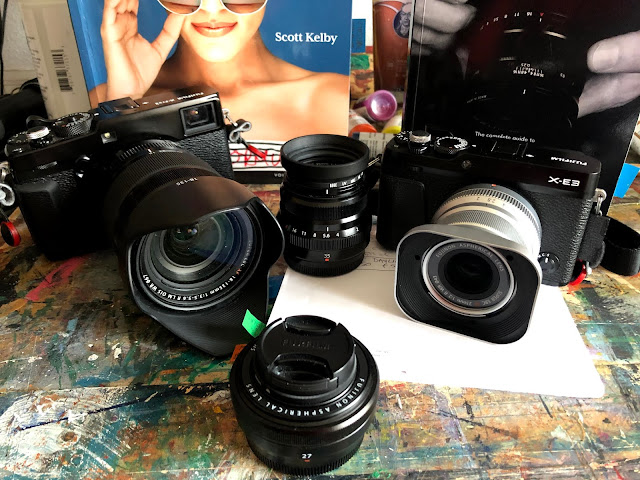The stable, pre-Torino
Nick and I had planned a trip to Torino in the Piedmont, northern Italy for some time. We were going over with our wives and visit our cousin Shelly and her husband Gian Pierro. The plan was to stay in Torino for a few days then travel by train to Alba and spend a week photographing, wine-sampling, eating and did I mention taking photos?
After assessing my stock of camera equipment (above), I decided they wouldn't fit the bill. They would work, but for the type of photography I like to do, they were not suitable. The Canon G-11 on the left is a great travel camera I bought in 2010, but it does not reach out and "touch them". I found that the zoom was not up to what I wanted to be able to do on occasion.
So, around 2015 I bought the Nikon 1V2, a new system introduced by Nikon a couple of years earlier. With it I bought a zoom lens which suited my needs and was very happy with it...until the zoom croaked in the middle of a trip to Cadiz, Huelva, Caceres and other great cities in Spain. I did some research and found that the system had been discontinued recently and that the main cause was that Nikon had floated badly engineered and produced lenses to go with the body as a "trial balloon" for another system. I had used Nikon cameras since the early seventies with absolute confidence and no mechanical problems ever. With the demise of film photography, I went back to Canon SLRs and sold my trusty film Nikons with sorrow.
Not liking or understanding digital, I gave away the remaining Canon and bought an HP point and shoot which I used until the Spanish Adventure started and I bought the G-11.
When I started doing long-distance bike touring, the need for an all-weather camera became evident and I bought the Fujifilm Fine Pix XP-50, a water and shock proof camera. It has served me well on bikes, in kayaks and all sorts of outdoor activities.
Back to the Nikon 1V2. The body was still fully functional and I really like the camera, so I gave in to a bright idea. I would buy a normal (50mm) Nikon F-mount lens and using an adaptor ring, mate it to the 1V2. It would operate only in the manual mode, but I could still use TTL metering. Once it was set up, the gear worked perfectly...except that I was stuck with about a 90 mm (35mm equivalent) lens. Good for portrait shots, but little else.
These would not do for the trip to Italy.
Not liking or understanding digital, I gave away the remaining Canon and bought an HP point and shoot which I used until the Spanish Adventure started and I bought the G-11.
When I started doing long-distance bike touring, the need for an all-weather camera became evident and I bought the Fujifilm Fine Pix XP-50, a water and shock proof camera. It has served me well on bikes, in kayaks and all sorts of outdoor activities.
Back to the Nikon 1V2. The body was still fully functional and I really like the camera, so I gave in to a bright idea. I would buy a normal (50mm) Nikon F-mount lens and using an adaptor ring, mate it to the 1V2. It would operate only in the manual mode, but I could still use TTL metering. Once it was set up, the gear worked perfectly...except that I was stuck with about a 90 mm (35mm equivalent) lens. Good for portrait shots, but little else.
These would not do for the trip to Italy.
Enter the Fujifilm stable
Being a dinosaur, I like the "retro" look in pretty much everything. I still wear a Burberry raincoat which is pushing forty years. My favorite luggage is leather and my blue jeans don't have ripped knees. Therefore, when I saw the Fujifilm X-Pro2 for the first time, I knew I had to own it. Not only did it look like a rangefinder, but it was a highly respected, mirrorless, almost state-of-the-art "street" camera.
My downfall was ordering it with the normal lens. I had misgivings about that from the start, but I wanted to go back to basics and start again. This was September '19. By November I had the 18-135 Zoom so I could reach out. This would halve been fine, but the setup was big, heavy and not inconspicuous; a quality I wanted for street photography. Enter the X-E3, a "little brother" to the X-Pro2 which could use the same lenses. I figured that since I had a loose 35mm lens which had come with the X-Pro, I could mount it on the X-E3. It would do, but was still fairly bulky and not wide enough. That led me to the 27mm "pancake" lens for the X-E3 to shed some bulk. That it did, but it still wasn't wide enough, giving me the 35mm equivalent of a 41mm lens-too close to normal. Finally, I settled for the 23mm or an equivalent to a 35mm in 24x36 format. Enough, already! Two new bodies, four lenses, a new tripod (I gave away two when I left the US), new strap system, filters and lens hoods, a manual to explain everything I ever needed to know and a book on LightRoom, a post-processing system similar to Photoshop. Oh, did I mention the camera bags? I bought one which was perfect, held everything, protected it all and looked like a camera bag-Duuuuhhhh? So I bought a leather rucksack for an obscene price and a universal insert to protect the two cameras and one lens.
Then Covid-19 happened and I'm locked down at home. All dressed up and nowhere to go...


No comments:
Post a Comment